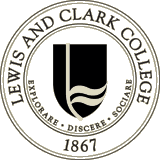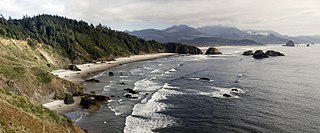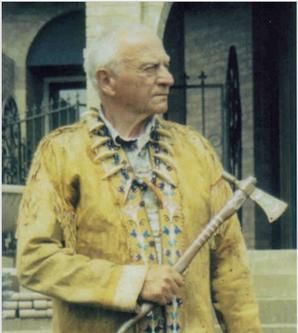Related Research Articles

The Compact Cassette, also commonly called a cassette tape, audio cassette, or simply tape or cassette, is an analog magnetic tape recording format for audio recording and playback. Invented by Lou Ottens and his team at the Dutch company Philips, the Compact Cassette was released in August 1963. Compact Cassettes come in two forms, either containing content as a prerecorded cassette (Musicassette), or as a fully recordable "blank" cassette. Both forms have two sides and are reversible by the user. Although other tape cassette formats have also existed—for example the Microcassette—the generic term cassette tape is normally used to refer to the Compact Cassette because of its ubiquity.

Florence is a coastal city in Lane County, in the U.S. state of Oregon. It lies at the mouth of the Siuslaw River on the Pacific Ocean and about midway between Newport to the north and Coos Bay to the south along U.S. Route 101. As of August 14, 2023, the city had a total population of 9,553.

Yachats is a small coastal city in the southernmost area of Lincoln County, Oregon, United States. According to Oregon Geographic Names, the name comes from the Siletz language and means "dark water at the foot of the mountain". There is a range of differing etymologies. William Bright says the name comes from the Alsea placename yáx̣ayky. At the 2020 census, the city's population was 994.

Betamax is a consumer-level analog recording and cassette format of magnetic tape for video, commonly known as a video cassette recorder. It was developed by Sony and was released in Japan on May 10, 1975, followed by the US in November of the same year.

Lewis & Clark College is a private liberal arts college in Portland, Oregon. Originally chartered in 1867 as the Albany Collegiate Institute in Albany, Oregon, the college was relocated to Portland in 1938 and in 1942 adopted the name Lewis & Clark College after the Lewis and Clark Expedition. It has three campuses: an undergraduate College of Arts and Sciences, a School of Law, and a Graduate School of Education and Counseling.

The Oregon Coast is a coastal region of the U.S. state of Oregon. It is bordered by the Pacific Ocean to its west and the Oregon Coast Range to the east, and stretches approximately 362 miles (583 km) from the California state border in the south to the Columbia River in the north. The region is not a specific geological, environmental, or political entity, and includes the Columbia River Estuary.

There have been several cases of exploding whale carcasses due to a buildup of gas in the decomposition process. This would occur if a whale stranded itself ashore. Actual explosives have also been used to assist in disposing of whale carcasses, ordinarily after towing the carcass out to sea, and as part of a beach cleaning effort. It was reported as early as 1928, when an attempt to preserve a carcass failed due to faulty chemical usages.
The Oregon Department of Transportation (ODOT) is a department of the state government of the U.S. state of Oregon responsible for systems of transportation. It was first established in 1969. It had been preceded by the Oregon State Highway Department which, along with the Oregon State Highway Commission, was created by an act of the Oregon Legislative Assembly in 1913. It works closely with the five-member Oregon Transportation Commission in managing the state's transportation systems.

Oregon OR 126 (OR 126) is a 204.63-mile-long (329.32 km) state highway that connects coastal, western, and central parts of the U.S. state of Oregon. A short freeway section of OR 126 in Eugene and Springfield is concurrent with Interstate 105 (I-105).

The Oregon Dunes National Recreation Area is located on the Oregon Coast, stretching approximately 40 miles (64 km) north of the Coos River in North Bend to the Siuslaw River in Florence, and adjoining Honeyman State Park on the west. It is part of Siuslaw National Forest and is administered by the United States Forest Service.

Elmira is an unincorporated community in Lane County, Oregon, United States. It is located west of Eugene and north of Veneta and Oregon Route 126, near the Long Tom River and Fern Ridge Reservoir.

Cape Perpetua is a large forested headland projecting into the Pacific Ocean on the central Oregon Coast in Lincoln County, Oregon. The land is managed by the United States Forest Service as part of the Siuslaw National Forest.
Siltcoos is an unincorporated community in Lane County, Oregon, United States. It is about 13 miles (21 km) south of Florence on the east shore of Siltcoos Lake.
The Siuslaw News is a weekly newspaper published in Florence, Oregon, United States, since 1904. The News covers western Lane County, from the Pacific Ocean to Deadwood and Greenleaf, and from Yachats on the north to Gardiner on the south. Until 1960, it was known as the Siuslaw Oar and The West. It is published on Wednesdays and has a circulation of 4,000. The paper was published weekly until 2000, when its frequency was increased to twice-weekly, and returned to weekly publication in July 2022.
The Oregon Commission for Women established the Oregon Women of Achievement in 1985 to recognize the accomplishments of Oregon women and to demonstrate appreciation for their endeavors. Qualifying candidates to be nominated for the Oregon Women of Achievement are exemplary role models who promote the status of women in society, are committed to diversity and equity and have earned recognition for success and leadership in their fields. As of 2013, 81 women have been honored by the Oregon Commission for Women.

The Österreichische Mediathek is the Austrian archive for sound recordings and videos on cultural and contemporary history. It was founded in 1960 as Österreichische Phonothek by the Ministry of Education and has been a branch of the Technisches Museum Wien since 2001. As video and sound archive, the Österreichische Mediathek is responsible for the preservation of the Austrian audio-visual cultural heritage.

Wilbur E. Ternyik was an American civic leader who has been characterized as a founding father of coastal planning, a coastal advocate, and a guardian of the Oregon Coast. News coverage of his work has described him as an international expert on sand dunes, and has noted his "decades of work to protect the environment that draws thousands to the Oregon coast." Ternyik's outreach to skeptical local officials in the early 1970s, persuading them to engage with then-Governor Tom McCall's call for land use planning in advance of the state's landmark land use legislation, has been identified as his most significant achievement.

The Siuslaw jetties at Florence, Oregon, in the United States, are parallel rubble-mound structures at the entrance of the Siuslaw River, bounding the north and south banks and protecting the navigation channel. The jetties extend into the Pacific Ocean, with spur jetties designed to reduce breakers and shoaling across the sand bar.
Canary is an unincorporated community in Lane County, Oregon, United States.
References
- ↑ "Pioneer Museum | Siuslaw River History". Siuslaw Pioneer Museum. Retrieved 2023-10-14.
- ↑ "Siuslaw Pioneer Museum News" (PDF). Spring 2023.
- 1 2 Teece, Jim (2022-06-06). "Siuslaw Pioneer Museum Receives Critical Funding From Bonneville Power Grant Through Florence Area Chamber Of Commerce". Southern Oregon Business Journal. Retrieved 2023-09-04.
- ↑ Duvernay, Adam. "Fifty years later, Florence embraces the tale of the exploding whale". Statesman Journal. Retrieved 2023-11-02.
- 1 2 Siuslaw Pioneer Association (1975). The Siuslaw Pioneer (downloadable .pdf). Florence, Oregon: Siuslaw Pioneer Museum.
- ↑ "Siuslaw Pioneer Museum may get a new home" . The Register Guard. June 12, 2005. ProQuest 377755282 . Retrieved 2023-10-18– via Proquest.
- ↑ "Florence 'oral history' compiled by Stafford". The World. 1976-07-26. p. 14. Retrieved 2023-09-04.
- ↑ "Volunteer works to help keep history alive" . The Register-Guard . February 20, 2002. p. B2. ProQuest 377755282 . Retrieved 2023-09-04– via ProQuest.
- ↑ Lobey, Deb (April 21, 2023). "Siuslaw Pioneer Museum's Oral History Project Recordings Converted to CDs". Siuslaw News. Retrieved 2023-09-04.
- ↑ Fleagle, Judy (2014). Around Florence. Arcadia Publishing. p. 114. ISBN 978-1-4671-3152-0.
- ↑ "Siuslaw Pioneer Museum may get a new home". The Register Guard . June 12, 2005. pp. C2. ProQuest 377747609 – via Proquest.